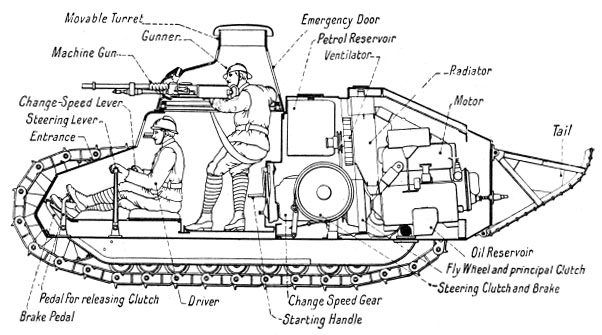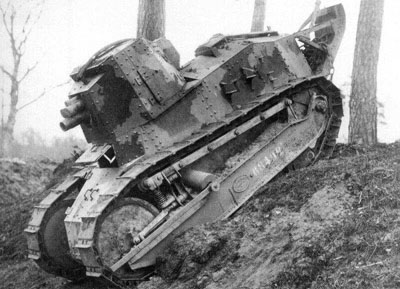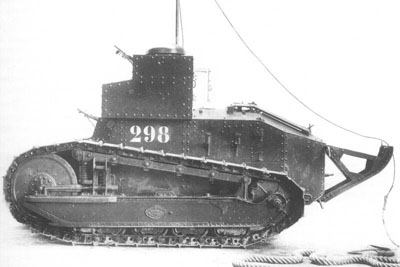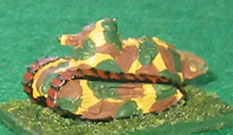|
Renault FT-17 and FT-31DescriptionThe Renault FT-17 was probably the first modern most successful tank in World War I. However by 1940 it was obsolete and no match for the German Panzers it faced.
DevelopmentThe car manufacturer Louis Renault started looking into producing a light inexpensive tank in May 1916; the job being given to one of his most talented designers: Rodolphe Ernst-Metzmaier. With features such as a turret with 360° traverse, the project was far more advanced than the two models of heavy tanks that were just entering production (the Schneider CA1 and the St. Chamond). Despite this the heavier tanks were favoured by the Ministry of Armament and without the support of Brigadier General Jean-Baptiste Eugène Estienne (The Father of French Tanks) the project would not have gone ahead. A wooden mock-up was built in 1916 followed by a prototype called the "Char Mitrailleur" which was first shown in January 1917. It was tested at the Billancourt factory in February and then in April at the Centre Artillerie Speciale located at Champlieu. An order for 100 tanks was then placed and manufacture started, 84 vehicles were produced in 1917. Production increased dramatically and 2697 tanks were delivered to the French army before the end of the war. Although the exact number produced seems uncertain, 3177 were delivered to the French Army, 514 to the U.S. Army and 3 to the Italian army. The first 100 tanks had a cast round turret into which nothing heavier than a machine-gun could be mounted. Following this two new turret types were adpoted; the octaganal "Omnibus" turret made of bolted rolled armor plates and the rounded "Girod" or "Berliet" turret made of several rivited cast armor plates. These latter two turrets could mount a 37 mm Puteaux SA 18 gun or an 8mm Hotchkiss Mle 14 machine-gun. The gun armed tank was designated FT-17c (canon) and the machine-gun armed tank FT-17m (mitrailleur). Roughly 40% of the tanks produced were armed with the 37mm and 60% with the 8mm machine-gun. It should be noted that this is not the in same proprtion as tanks ordered; 60% of the tanks ordered were to have the 37mm and only 40% a machine gun.. Although some books use the term FT-18 this never seems to have been used by the French army or contemporary sources. The FT-17 had a crew of two; a driver in front and a commander/gunner in the turret. The driver entered the tank through the double door in the front which formed the decking. He sat om a canvas seat on the floor, this was uncomfortable when travelling cross-country as it absorbed almost none of the motion of the tank His view of the outside was provided by three vision slits and a shutter; although the shutter was not opened when on the battlefield. The gunner entered the tank through the hatch at the rear of the turret. He had a canvas belt sling, serving as a seat, attached to the sides of the manually operated turret. The turret had no hatch, instead it had a cupola, a mushroom shaped dome with with five observation slits. In 1931 the 1580 FT-17 mitrailleur tanks remaining in service in the French army had their machine-gun upgraded from the 8mm Hotchkiss to the 7.5 mm Reibel MAC31. This model was known as the FT-17 modifié 31 and was sometimes (although not officially) referred to as the FT-31.
ServiceWorld War I The role of the FT-17 was infantry support. Its main task was to eliminate machine-gun nests and destroy barbed-wire obstacles, enabling infantry to cross the no-man's-land and to pierce the enemy lines. Although French infantry were happy to have the tanks in support, neither they nor the tanks recieved any special training. German field guns were the main threat accounting for 356 out of the total 440 FT-17s that were destroyed during the war. Enemy tanks, specialist anti-tank weapons (like the Mauser anti-tank rifle) and mines were only a secondary threat. Terrain problems such as trenches and shell holes put more tanks out of action than enemy fire although such damage could be easily repaired. Between the Wars Betwen World War I and II the FT-17 tanks took part in many smaller wars and conflicts including the Russian Civil War, the Polish-Soviet War, the Chinese Civil War and the Spanish Civil War. World War II Although by then completely obsolete, the FT-17 tanks were still used by France, Poland, Germany and Finland during the Second World War. When the Second World War started, the infantry support role was still a major part of the French tank doctrine and tanks were distributed throughout the army in small penny-packets Being intended for an infantry support role, they had very few AP rounds, only enough to defend themselves against enemy tanks, the vast majority being HE rounds. It was intended to have completly replaced the Renault FT-17 tanks with modern Renault R-35 or R-40 tanks by 1940. However insuficient modern tanks had been built so one thousand F-17s went to war in the same role as they had a generation earlier. Their survieability was much lower as they made easy targets for German panzers and specilist anti-tank guns as well the field artillery and when these were unavailable, such as at the crossing of the Meuse, they even fell foul of hollow-charge equipped combat engineers. The American army's first contact with an enemy tank in WW2 was with the FT-17. During the 1942 landings in North Africa the Vichy French forces advanced with seven FT-17s supported by infantry. These were repulsed by three Stuart light tanks under the command of General George Patton. The Americans destroyed three FT-17s without loss. Their final use in combat was in 1944 when the Germans used them in the street fighting in Paris.
OperationThe commander was very overworked in the one-man turret. Apart from directing the driver and keeping in touch with other tanks in his unit (by flags) the commander was also the main gunner and loader. So in action he would have his head in the cupola directing the driver, he would then have to spot the target and jump down into the turret when he would load with the correct ammunition, rotate the turret by hand onto the target, peer through the gun-sight and set the range, finally fire the gun. This was not so much a problem in 1918 when the targets were most often stationary such as machine-gun nests and only occaisionally slow moving. When the French encountered the fast moving Germans in 1940 the problem became extreme. The turret had a cupola with five vision slits where more modern tanks would have a turret hatch. The commander could not raise his head out of the turret and thus had a more restricted view than was possible for German tank commanders who often when into battle so exposed. As was normal for French tanks there was no intercom. However the absence of partition between the driver and the turret allowed the commander gave his orders to the driver by nudging his back with a knee to change direction, and while tapping on his helmet to start or stop. The hard (almost lack of) suspension made the ride very hard and the high centre of gravity made cross-country travel very dificult. Some very nice foot work with the clutch and brake was called for from the driver to make the ride even bareable and avoid serious injury to himself or the commander. VarientsThe Char Renault FT BSThe Char Renault FT BS was a self-propelled gun mounting a 75mm Blockhaus Schneider L9.5 short-barrelled howitzer in a seven-sided rivited superstructure that replaced the turret. This increased the vehicle's weight to 7.2 tons. Due to the size of the gun, ammunition storage was redude to only 30 rounds. An order was placed for 970 units but because of the Armistice in 1918 only 39 vehicles were produced. Whether any saw service in France during 1940 is uncertain. Some saw action in North Africa between the wars and were encountered there by the allies during the Torch invasion.
The Char Renault FT TSFThe Char Renault FT TSF (Télégraphie Sans Fil) was a command tank. The turret was replaced by a box-like superstructure giving room for a crew of three; driver, radio operator and observer. The vehicle was equipped with an ER10 ter morse code-only wireless, its wire antenna was hung between a mast mounted on the superstructure and the vehicles tail. The vehicle had no armament. 300 vehicles were ordered of which 188 were produced. Whether any saw service in France during 1940 is uncertain.
DeploymentThe Renault FT-17 light tanks equipped a number of front-line independant tank batalions and companies; BCC and CACC. They also equipped a number of second-line and training units such as regional tank platoons, anti-paratroops tank companies, airfield protection platoons and the Paris military region special group. 10th May 1940When the Germans's attacked the French army had 630 Renault FT-17 tanks in front-line combat units of which 525 were in France. Units all contained a mixture of FT-17c and FT-17m mle 31 tanks; in what proportion is unsure.
In addition the following was formed May, 21st:
In total 1297 FT-17 tanks were still in service; 1062 tanks in France and 235 in the colonies.
Technical Data
| ||||||||||||||||||||||||||||||||||||||||||||||||||||||||||||||||||||||||||||







